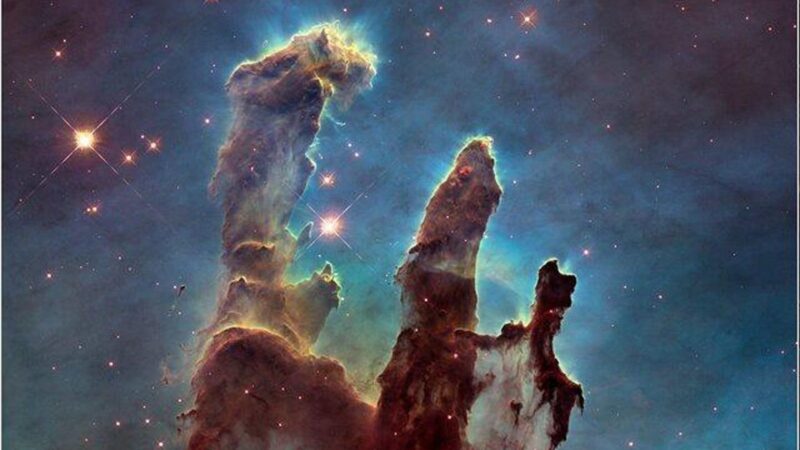Topline
Two comets will be visible in different parts of the night sky on Friday, Oct. 17, 2025, one of them close to a bright star and the other passing close to one of the night sky’s most iconic sights. The brightest of the two, Comet Lemmon (C/2025 A6), will shine close to Cor Caroli near the Big Dipper, while Comet SWAN (C/2025 R2) will on Friday, Oct. 17, 2025, appear next to the iconic “Pillars of Creation” in the Eagle Nebula (M16). Both comets are predicted to become even brighter next week during the peak of the Orionid meteor shower on Oct. 20-21.
The NASA/ESA Hubble Space Telescope made the Pillars of Creation famous with its first image in 1995.
NASA, ESA, CSA, STScI; J. DePasq
Key Facts
On Friday, Oct. 17, 2025, Comet Lemmon will be visible both after sunset and before sunrise close to the Big Dipper in the northern night sky, while Comet SWAN will be visible in the southwest after sunset. The best time to look for both will be about 90 minutes after dusk.
The Comet Observation Database reports Comet Lemmon to be shining at magnitude +5.2 and Comet SWAN a little dimmer at magnitude +5.9. That makes them both almost bright enough to be seen by the naked eye from a dark sky site, but a pair of 8×42 or 10×50 binoculars is, in practice, necessary to see them from most locations.
Comet Lemmon will be found very close to Cor Caroli, a double star about 115 light-years from the sun whose name means “Charles’ Heart.” This comet was discovered on Jan. 3, 2025, by the Mount Lemmon Survey near Tucson, Arizona. It takes around 1,350 Earth-years for it to complete one orbit of the sun.
Comet SWAN was only discovered on Sept. 11, 2025, as it exited from the sun’s glare, and is currently travelling away from the sun. It takes about 22,554 years to complete one orbit.
An easy way to find the location of the comets is to use the finder charts at In-The-Sky.com or stargazing apps such as Sky Guide, Stellarium and SkySafari.
Comet Lemmon can be seen before dawn on Oct. 17 — the best time will be 5:40-6:10 a.m. EDT.
Stellarium
When And Where To See The Comets
The best time to spot Comet Lemmon and Comet SWAN on Friday, Oct. 17, is during a 30-minute window starting about 90 minutes after sunset where you are. Both are visible after sunset but in opposite parts of the sky — Lemmon in the northwest, SWAN in the southwest. For New York City, where sunset is at 6:09 p.m. EDT, the ideal time for evening viewing is 7:39-8:09 p.m. EDT.
Comet Lemmon can also be seen before dawn. Look during a 30-minute window beginning about 90 minutes before sunrise. With sunrise at 7:10 a.m. EDT in New York, the best time will be 5:40-6:10 a.m. EDT — though earlier observations may also reveal the comet rising in the northeast.
The best time to see Comet Lemmon on Oct. 17 will be 90 minutes after sunset.
Stellarium
How To Find Comet Lemmon
Distance from the sun: 68.2 million miles (109.7 million kilometers)
Distance from Earth: 57.5 million miles (92.6 million kilometers)
Before sunrise, the comet will be in the northeast. This time, the Big Dipper’s handle will point down toward the horizon. Look to the right side of the bright star Alkaid at the end of the handle for the star Cor Caroli, the brightest in the simple two-star constellation of Canes Venatici. Lemmon is just below it. From New York, the comet will stand about 13 degrees high — approximately the span of your outstretched fist — at 5:40 a.m. EDT, and will climb higher as dawn approaches. Venus rises at about the same time. Also in the pre-dawn sky will be a lovely 14%-lit waning crescent moon.
After sunset on Friday, Oct. 17, look for Comet Lemmon roughly below the curved handle of the Big Dipper. It will be to the upper left of Cor Caroli in Canes Venatici. Its height above the horizon varies by location, but from New York it will appear about 13 degrees above the northwest horizon at 7:39 p.m. EDT — roughly the width of four fingers held at arm’s length — and will gradually sink as twilight deepens.
The best time to see Comet SWAN on Oct. 17 will be 90 minutes after sunset.
Stellarium
How To Find Comet Swan
Distance from the sun: 87 million miles (140 million kilometers)
Distance from Earth: 24.6 million miles (39.6 million kilometers)
Blueish-green Comet SWAN — only discovered in September — will be visible in binoculars on Friday, Oct. 17, 2025, low in the southwest after sunset. SWAN will be above the famous “Teapot” asterism in the constellation Sagittarius, close to the Eagle Nebula (M16), a nursery for newborn stars that contains the famous Pillars of Creation. It’s in front of the Milky Way, so expect dense starfields to be visible behind the comet in binoculars. From New York, it will appear about 29 degrees above the southwest horizon at 7:39 p.m. EDT.
Comet SWAN on Oct. 17 will be close to the “Pillars of Creation” in the Eagle nebua (M16).
Stellarium
Comet Swan And The ‘pillars Of Creation’
On Friday, Oct. 17, Comet SWAN (C/2025 R2) will drift across the Eagle Nebula, passing in front of the region made famous by the James Webb Space Telescope’s 2022 portrait of the “Pillars of Creation.” Webb’s infrared view pierced the dust to reveal hundreds of protostars — young stars forming within towering columns of gas. Red orbs mark newborn stars, while glowing ridges trace shock waves from stellar outflows, carving the nebula’s edges. Compared with Hubble’s 1995 and 2014 images, Webb’s sharper, deeper look shows how stellar winds sculpt the pillars over time — a living nursery of stars, now momentarily the backdrop to a passing comet.
Check my feed every day this month for a daily “comet tracker” with finder charts and tips for viewing Comet Lemmon from mid-northern latitudes.








